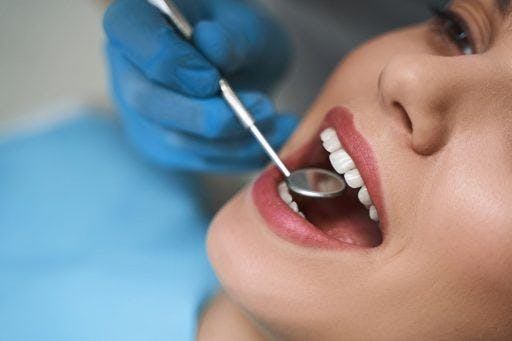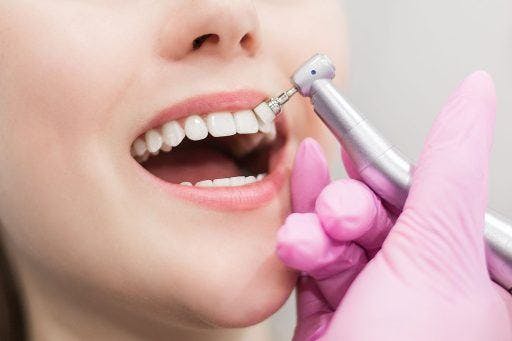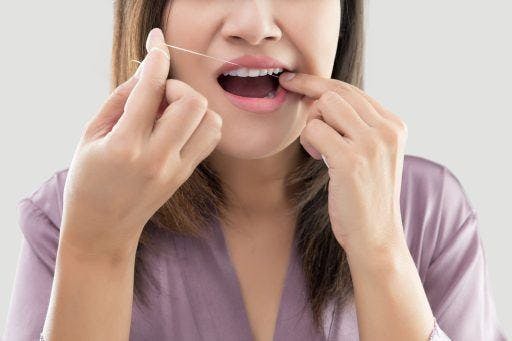Oral care goes beyond daily hygiene practices. Yes, brushing twice daily and flossing between meals are valuable steps – but they’re not enough. There’s only so much your trusty toothbrush can do. That’s why professional dental cleaning is a critical part of upkeep.
The process provides a deeper clean that reduces the risk of cavities, periodontitis (gum disease), and other serious issues. It also allows your dentist to monitor your oral health closely, so they can catch any problems before they worsen. And as a bonus, teeth often look whiter and brighter after the procedure.
Dental cleaning procedures to expect during your appointment

Here’s what you can expect at your next dental checkup if you’re going in for cleaning.
1. Oral exam and X-ray
Every round of cleaning starts with a physical checkup. In this initial step, your dentist uses a mirror to check your mouth for signs of tooth decay, gum inflammation (gingivitis), and other conditions.
They may then perform a digital scan if it’s your first time seeing them or if you haven’t undergone professional cleaning in six months or more. X-rays allow your dentist to spot any deeper, underlying issues requiring treatment.
2. Scaling
Scaling involves the removal of plaque and tartar on the teeth’s surface. Tartar is a form of calcified plaque that coats the teeth and gums. Large amounts of stubborn buildup may require an electronic or ultrasonic scaler, while a manual scaler should be enough to scrape off minimal accumulations.
Your dentist may need to go over some areas multiple times. The process should be relatively painless unless you have sensitive gums. Be sure to speak up if you experience any discomfort during this phase.
3. Cleaning and polishing

Some dentists use a special type of toothpaste with a gritty texture to polish the teeth after scaling. This substance is known as a prophylaxis paste. Together with a high-powered electric brush, it removes leftover plaque, stains, and bacteria. The cleaning results in a smoother, shinier smile.
The paste provides a more thorough clean versus regular toothpaste due to its abrasive texture. Given this, it’s best to leave the teeth polishing to professionals. Attempting the procedure at home with DIY supplies can wear down your enamel and weaken your teeth.
4. Rinsing with fluoride
Finally, your dentist will get you to gargle with a liquid fluoride-infused rinsing solution to wash away residue. Fluoride is a mineral that strengthens teeth, helps prevent cavities, and restores enamel.
5. Other preventative treatments
Oral health needs vary from patient to patient, so ask your dentist if you need to undergo additional procedures. They may offer dental sealants, fluoride treatments, or expert flossing as added protection from cavities, especially if you’re at risk.
How to prepare for a dental cleaning
Get the most out of your next dental visit with these tips:
- Confirm your appointment: Double-check the date and time to ensure you’re all set.
- Pre-clean your teeth: Brush and floss to remove food particles. This helps your dentist get a clearer assessment of your oral health.
- Avoid whitening products: Skip any at-home whitening treatments unless recommended by your dentist, as they might cause sensitivity during your cleaning.
- Prepare your questions: List down any questions or concerns so you don’t forget them during your appointment.
- Arrive early: Allow some extra time to fill out any necessary forms or paperwork before your appointment.
Which type of dental cleaning should you choose?
There are three main types of dental or teeth cleaning: prophylaxis, gross debridement, and scaling and root planing. Each one varies in intensity, but all tackle harmful bacteria by managing plaque and tartar.
Prophylaxis is the most common and takes about 30 minutes to an hour. Go for this procedure if you have generally healthy teeth and gums. The other two options are best for those with extensive buildup and mild to moderate periodontitis. In any case, your dentist will let you know which one suits your needs.
How malocclusion affects cleaning

You may struggle to brush and floss effectively if you have misaligned teeth. Crookedness, crowding, and other malocclusions make the spaces between teeth harder to reach. When you’re not cleaning effectively at home, you’re more likely to develop plaque, tartar, and all the problems that come with them. You’ll also need to come in for more frequent dentist visits to stay ahead of potential damage.
You don’t have to put up with misalignment if it’s negatively impacting your quality of life. Get ClearCorrect aligners for a discreet, comfortable solution to teeth misalignment. These orthodontic devices apply gentle, consistent force on teeth to correct them, making them easier to maintain.
Take this online smile assessment to find out if you’re a candidate for aligners. You can also ask your dentist about treatment plans at your next appointment.
What will be cleaned during dental cleaning?
During a dental cleaning, your dentist will thoroughly clean your teeth to remove bacteria, plaque, and tartar buildup. They may also examine your tongue and gums to assess your overall oral health.
How often should you get your teeth professionally cleaned?
The Australian Dental Association (ADA) recommends that most adults visit the dentist every six to 12 months for a routine cleaning and examination. You may need to come in more frequently, depending on your condition.
If dental cleaning isn’t a regular part of your oral health routine, this is your sign to change that. Contact your dentist and schedule a visit ASAP – give your smile the attention it deserves!
References:
Barrell, A. (2022, December 8). What is dental prophylaxis?
Brushing and flossing. (n.d.).
Professional, C. C. M. (n.d.). Dental Cleaning. Cleveland Clinic.



